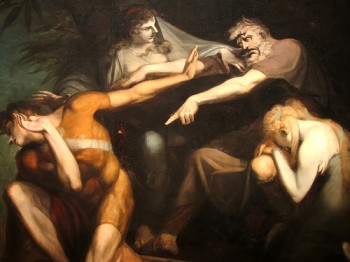In Henry Fuseli’s Oedipus Cursing His Son he see an scene that depicts a large range of commotion and negative emotions. There is so much angst, sorrow, and pain exhibited in this painting, which goes along with many scholars’ viewpoints of Fuseli. Fuseli was an artist that loves to examine sexuality, pain, and non-harmonious nature of human kind. He constantly depicts scenes of apocalyptic nature. So it makes sense that he would paint a scene from one of the most sexually charged and twisted plays of history. Oedipus story of love, and despair is always treated as one of the best examples of the twisted nature of humankind as well as the ways we could be messed up sexually. Fuseli is described as “erudite, nervy and essentially modern painter whose grand and sometimes apocalyptic work goodness is tested, innocence has little chance and menace and violence have a sexual edge”(Michael).
Oedipus is a terrific painting that shows how much these characters are exposed. Oedipus’s son is fully nude but at the same time while being physically exposed he is also emotionally exposed. Michael Brenson’s New York Times article examines such thoughts after viewing a recent gallery of Fuseli’s work. “The sexuality, including the homoeroticism, that is restrained in Michelangelo's nudes begins to rumble in Fuseli's paintings and drawings. With Fuseli, the ideal male nude suddenly seems emotionally exposed and truly naked.”
On the more analytical side one could see how Fuseli used color and line to create and own his traits of sexuality, pain, and scenes of apocalyptic nature. First off, we have talked about Oedipus’ son being fully exposed but at the same time he is painted in color. It is unclear if this is a very tight suit or merely an artistic choice. He is the only one in the image to have any value in color. Everyone else in the painting seems to be in grey tones or white tints. The use of color could perhaps be used to show Oedipus is perhaps unfeeling and void of emotion while the son has a soul or passion.
As well the use of line creates an overall sense of transition of power. Oedipus is scolding his son so it makes sense that he is above the son. The diagonal line creates a clear sense of who has the power in this situation. The women create another line that is almost perpendicular to the Oedipus-Son line. Which connects the characters as well as adding the visual “flow” of the painting. As well the two females fill the voids of the painting while at the same time add more emotion to the image.
Every character in this scene shows a complex variety of emotions that exemplifies everything what scholars feel Henry Fuseli was trying to say about the human condition. The type of art that Fuseli was doing at the time was relatively modern and he was making bold statements that come across very clearly in his paintings. We are not a harmonious elegant society. We are corrupt, we are broken, and we will drive ourselves to apocalypse.
MICHAEL, BRENSON. "Review/Art; Henry Fuseli's Drawings of Life's Lusts and Compulsions." New York Times 04 Jan. 1991: 20. Academic Search Complete. Web. 29 Feb. 2012.

It's interesting how in the earlier Baroque period, diagonal lines were often used to draw the viewer into the scene. In this case, though, Fuseli is created strong diagonal lines to stop the viewer from accessing everything in the scene; the woman in the background is blocked by the outstretched arms of the men.
ReplyDelete-Prof. Bowen
This is a very interesting painting by Henry Fuseli. Like you have mentioned, it shows a variety of emotions, most of them related to sadness and anguish. A viewer can feel the intensity of the painting in the bold diagonal lines and the expressions on the subjects' faces. The whole scene speaks of a tragedy that might have come upon this group of characters. Great post!
ReplyDelete